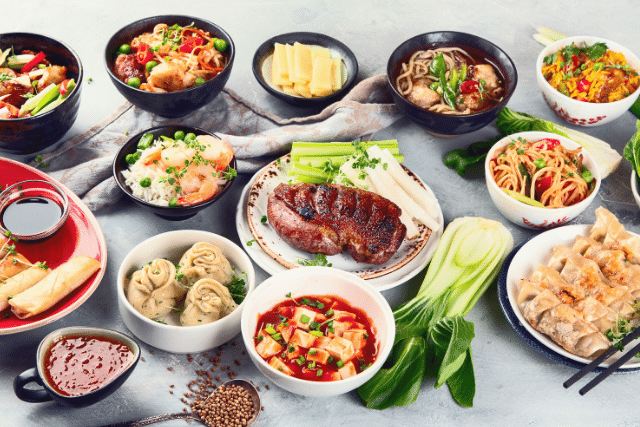
Traditional dishes that are cooked during Chinese New Year in Singapore
Traditional dishes that are cooked during Chinese New Year in Singapore
Singapore is a city-state in Southeast Asia home to varied cultures. Behind the colossal structures, rapid development, and bustling metropolis are the Chinese, Malay, Indian, and various other ethnic groups. Singapore is even the "Congregation of many cultures live together in one hospitable place."
Its association with the Chinese community is not new to the eyes of many. Singapore and China commemorated the 25th anniversary of diplomatic ties in 2015 with the issuance of a Joint Statement as an "All-Round Cooperative Partnership Advancing with the Times.".
Moreover, when it comes to celebrations, whether it is Chinese New Year, Hari Raya Aidilfitri, Deepavali, Vesak Day, or Christmas, Singaporeans of all nationalities and faiths celebrate together as if it is their main home of the feast. That is how open to culture Singapore is when it comes to celebrations.
Chinese New year is a 15-day holiday observed annually in China and Chinese populations worldwide. It starts with the new moon, which falls on Western calendars between January 21 and February 20. The celebrations continue till the full moon follows. The festival is sometimes called the Lunar New Year because it coincides with lunar phases. Since the mid- 1990s, Chinese New Year celebrations have included seven consecutive days off work. Different countries do this celebration differently, and no country celebrates it like Singapore.
When the Chinese New Year approaches, the whole country stops working, not just the estimated 75% of Chinese. Over the years, Singaporeans have put their unique flavors into the Chinese New Year festivities by combining old and new rituals and cultures. Singapore's Chinese New Year celebrations are memorable. They will indeed paint the town red when this feast comes.
Besides, one cannot miss the popular festive melodies, family reunion feasts, colorful parades, and lots of lion dances throughout this festival, with specific programs accessible for viewing from home. In addition, a celebration like this would not be complete without the dishes to be eaten. During Chinese New Year's eve, the family reunion feast and ancestor worship are two of the most significant aspects of the night's rituals.
Chinese New Year makes Singaporeans busy choosing the dishes they will eat for the evening. Food is provided in abundance during this gathering, regardless of the family's riches or poverty. The Chinese believe that having an excess of food at tuanyuan would bring the family excellent material fortune in the new year.
In addition, Singapore has different dialects that China influenced. These dialects have different ways of celebrating Chinese New Year and different dishes served on this occasion. Michelin(dot)com presents us with each dialect's traditional dishes.
- Hokkien Traditional Dishes
With two-fifths of the Chinese Singaporean population, the Hokkien community is the most popular linguistic group. Its traditional cuisine includes an astounding array of dishes. Traditional Hokkien food is also simple, says Tho Cheng Kia, the proprietor of Quan Xin Yuan. It is all about the taste!
One of the traditional food in this dialect is the Mee Sua. Mee sua is a noodle meal traditionally eaten with the whole family on the first day of the Lunar New Year. This dish is defined by thin rice noodles, which represent longevity. They are served in a transparent broth with two hard-boiled eggs, which are considered auspicious, and some pork.
Another traditional dish is the White Radish with Scallops. This is also called "cai tou" in Hokkien, which translates to good luck. Scallops and white radish's incredible sweetness complement one another well, and the combination is magnificent.
- Cantonese Traditional Dishes
When the occasion takes place, Cantonese dialect serves 'lap mei fan.' This is also called rice with cured meat. This fragrant rice meal is made in a clay pot with Chinese sausage, liver sausage, and preserved duck. Just before serving, this delicious mixture is drizzled with a sauce comprised of preserved meat oils, dark soy sauce, and light soy sauce.
However, no feast is complete without symbolic dishes. One method is to roast the entire animal, including the head and tail, to represent a great start and finish.
Furthermore, no matter how much they are full, every individual will always have room for dessert. A Cantonese home must have Nian gao. The sticky rice cake is made with glutinous rice flour and sugar and denotes 'nian gao' year and 'gao', meaning lofty or tall. Adults advancing in their occupations while youngsters grow larger and score better is symbolic and inspirational.
- Teochew Traditional Dishes
One of the essential dishes for the Teochew community is the Qi Yang Cai. a vegetarian meal served on the seventh day of the Lunar New Year that incorporates seven different types of vegetables with different meanings.
- 'cong' or Spring Onions - to be smart
- 'suan' or Leeks - one will have money to count
- 'qin cai' or celery - to be hardworking
- 'bai he' or lily bulb - hundred things will go well
In addition, they also like dishes with beancurd. This is because beancurd is referred to in Teochew as 'dao gua,' yet 'gua' also means 'official.' Consuming it represents the aspiration to become an official, bringing honor to the family and ancestral house.
Moreover, one of the dishes served in the Teochew dialect is the sea cucumber stuffed with minced meat, mushrooms, dried shrimp, water chestnuts, and sole dried fish. It is an important meal because sea cucumber is called 'hai shen,' which means progress. Stuffing an element also indicates manly or 'full' — to be brimming with richness.
Rabbitfish, also known as white stomach fish, is a popular meal during this season. Originally from Singapore, this custom began when a businessman ate this fish for New Year's and became incredibly rich. After that happened, it was linked with wealth as other business people followed the tradition.
- Hakka Traditional Dishes
Hakka foods are generally more rustic, and they must be filled.
Xing Ning's stewed pig belly is a popular dish. Garlic, sugar, and red yeast rice flavor the meat. The outcome is succulent pork with rich crimson color and a delicious scent.
Another dish that everyone loves is the Stuffed Three Treasures. Mr. Lai, a Hakka villager, made this meal by filling dried oysters with the stuffing from traditionally filled beancurd and rolling them in beancurd skin. Mr. Lai says that toufu signifies wealth in Hakka, dried oysters represent good fortune, and beancurd skin rolls represent prosperity rolling one's way.
- Nyonya Traditional Dishes
The Nyonya dialect might be regarded as the earliest mixed culture, predating the Spanish conquest of the Americas and establishing the Spanish mestizo culture.
As a starter for their celebration, they served Yee Sung or Lo Hei. It is a raw fish vibrant salad that consists of 25 ingredients in all. With their chopsticks in hand, visitors tossed and stirred the various components together while yelling "Lo Hei," which translates as "Tossing Prosperity." The purpose of such a fervent act is to continually draw the energies of success and good fortune into one's life for the year.
In addition, Chicken, Chinese Mushrooms, and Potato Stew are well-known Nyonya dishes among those acquainted with the culture. This cuisine is a staple on all Peranakan family dinner tables, mainly on celebratory days.
- Hainanese Traditional Dishes
The Hainanese community in Singapore originates in China's Hainan region. As mentioned in the 2010 census, the Hainanese minority is the fifth biggest Chinese dialect group in Singapore, accounting for less than 7% of the Chinese population.
Hainan families make steamed chicken (or ji) and mutton soup (or yang). Due to the similarity in pronunciation, they are often served together. Chicken is essential to each Hainanese celebration.
A typical evening dish is chives cooked with glass noodles. Longevity is represented by the long and thin strands of glass noodles, while wealth is represented by chives (gao sang).
Hainanese chicken rice balls and chin deh, a hollow glutinous flour ball covered with sesame seeds, is prepared. The spherical shape depicts family members "reuniting."
All in all, Singaporeans are paying so much respect and attention to these dishes and the overall celebration of the Chinese New Year. This makes Chinese New Year for the Chinese community in the country more memorable and commemorative.
SGWetMarket is one of the established wet market stalls that has been operating for more than 13 years. SGWetMarket provides next-day vegetables, meat, seafood, fish, and fruits delivery services in Singapore. They have a wide variety of choices with over 250 vegetables, meat, seafood, fish, and fruits choices that are available all day on our website. As all of their freshes produce is being picked and delivered on the same day, shopping for fresh produce has never been so easy. Their friendly customer service team is eager to assist with all your shopping needs. Visit https://sgwetmarket.com.sg for your online groceries needs!
